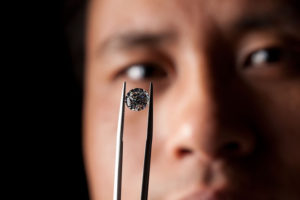The Billion Dollar Business of Diamond in China
To know more about the Diamond industry in China, contact us at dx@daxueconsulting.com
How Large is the Diamond Industry?
 The diamond industry is estimated to be USD $30 billion per year and the world’s leading diamond company is De Beers. The group and its partners produce a third of the world’s rough diamonds by value and solely owning mines and main distribution systems. In 2014, the revenue across the diamond industry value chain grew by 4% to 8% in spite of slow demands from China. Despite the performance in 2014, in 2015 there has been an uncertainty within this industry; the jewelry consumption rose sharply in the Chinese market in 2013 causing an inflated expectation of further growth in demand for the diamond jewelry. This has cause stock to accumulate throughout the diamond pipeline, causing price declines for both polished and rough diamonds by 12% and 23% respectively. In 2015, the diamond industry suffered a ripple effect from a decline in consumer demand that began in 2014 in Mainland China. According to research done by Daxue Consulting, the circulation of diamonds through the pipeline should be restored as soon as
The diamond industry is estimated to be USD $30 billion per year and the world’s leading diamond company is De Beers. The group and its partners produce a third of the world’s rough diamonds by value and solely owning mines and main distribution systems. In 2014, the revenue across the diamond industry value chain grew by 4% to 8% in spite of slow demands from China. Despite the performance in 2014, in 2015 there has been an uncertainty within this industry; the jewelry consumption rose sharply in the Chinese market in 2013 causing an inflated expectation of further growth in demand for the diamond jewelry. This has cause stock to accumulate throughout the diamond pipeline, causing price declines for both polished and rough diamonds by 12% and 23% respectively. In 2015, the diamond industry suffered a ripple effect from a decline in consumer demand that began in 2014 in Mainland China. According to research done by Daxue Consulting, the circulation of diamonds through the pipeline should be restored as soon as
mid-market companies and retail segments clear the excess inventory of diamonds. As China moves towards a consumption-based economy, sales are likely to grow in the next 5 to 10 years. De Beers agrees and anticipates an improvement by 2017, Anglo American has been increasing spending on marketing in China as the company plans to attract and target women between the age of 18 and 29. In the meantime, the company has cut its production and lowered prices at its sales.
Challenges of Diamond Industry
- Sustaining long-term demands for diamonds in developed markets
- Attracting younger generations of consumers
- Competition from boosting demand of other sources of luxury accessories
- Arrival of synthetic Diamonds
Since the arrival of synthetic diamonds (also known as HPHT diamonds or CVD diamonds), the whole industry has been affected as diamond grading laboratories have proved that these synthetic diamonds were physically and chemically indistinguishable from real diamonds. The fear is not whether the people will value synthetic diamonds as much as real diamonds but rather the concern that synthetic diamonds would be passed off as real diamonds. This risk of penetration of undisclosed synthetic diamonds remains; as consumers lose confidence in the entire diamond category. As technology progresses, synthetic diamond can be produced in an artificial process in laboratories or factories as opposed to natural diamonds which are geologically processed. Also, the price of synthetic diamonds costs 20% – 30% less in comparison to those diamonds that are naturally mined with significant or no difference in Carat weight, Color, Cut, and Clarity. This term of synthetic diamonds have been associated by consumers as imitation diamonds, however, they are produced with the same materials and process. Indeed, HPHT diamonds or CVD diamonds can be cut into gems with various colors such as clear white, yellow, brown, blue, green and orange.
However, the industry participants are actively addressing these concerns by:
- Tightening certification requirements
- Diffusing and adopting synthetic diamond detection technologies,
- Tightening legal and regulatory framework for synthetic diamonds.
As the appearance of these synthetic gems has caused concerns in the diamond trading business, spectroscopic devices and techniques have been developed to distinguish between synthetic and natural diamonds. The International Institute of Diamond Grading & Research offers methods that can verify the difference between grown and natural diamonds in a matter of minutes. For instance, Diamond View is a device that projects a fluorescent blue for natural diamonds while projecting fluoresce orange for lab-grown diamonds. Additionally, diamond buyers should be aware of certifications issued by a reputable agency from such as GIA, AGS, HRD, IGI, EGL, GSI, GCAL, and PGS allowing buyers to differentiate natural diamonds from synthetic diamonds.
What’s next for the Diamond Industry in China?
One of the key drivers for the growth of the diamond industry is pointed towards the strong growth of China. However, China is headed for its slowest economic growth since 1990 thus affecting the current state of the diamond industry as prices have also taken a steep dive by 12%. The outlook for the diamond market remains positive with demand expected to even out in 2019. Experts from Daxue Consulting predicts the demand for rough diamonds to recover and return to a long-term growth. This would rely strongly on the fundamentals in the United States and the continuous growth of the middle-class in China. Big players in the diamond industry believe that China’s demand for diamonds will pick up faster than the global average as gains in household wealth is driving a demographic and cultural shift across the nation.
Daxue Consulting: Industry Insight
An interview has been conducted by Arthur Seet, a consultant at Daxue Consulting with the Director of Rinky Gems Company, Aniket Mehta, to find out more about the diamond industry in Hong Kong and mainland China. Rinky Gems Company is a firm established in Bombay in the year 1985 that trades gemstones, mainly Diamonds, Sapphires and Ruby to the jewelers in Hong Kong. Mr. Mehta sees the competition in Hong Kong as a very competitive market with over 1000 companies, all practicing the same commercial activity in such a small island. However in China, the regulations imposed by the Government on foreign investments especially in luxury products creates an entry barrier thus, making it much easier for wholesalers to trade diamonds in China in comparison to Hong Kong. However, this does not include jewelry retailers, factories, and sellers which remain very competitive in China. Moreover, in order to trade diamonds legally in mainland China, firms would be taxed about 4% and will be required to register with the Shanghai Diamond Exchange. The future of this industry in Hong Kong will be mainly based on the rotation of money while China has a huge market scope and a great opportunity for investors. Within five years time when the market starts to balance out, Mr. Mehta plans to open an office in mainland China, in Shanghai, where there are huge opportunities along with the growing middle-class household in China which plays an important factor for the diamond jewelry market.
For more information on Rinky Gem Company please visit: http://www.rinkygemscompany.com




![[Podcast] China Paradigm 45: Analyzing the market for colored gemstones in China](../wp-content/uploads/2019/06/gemstones-China-podcast-150x150.jpg)









